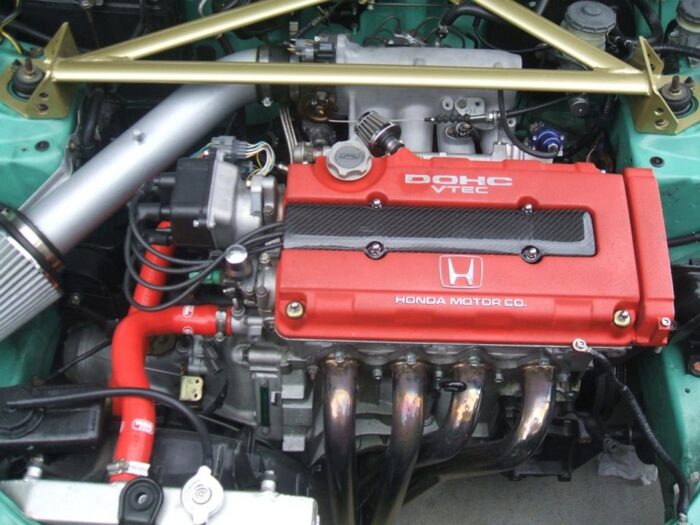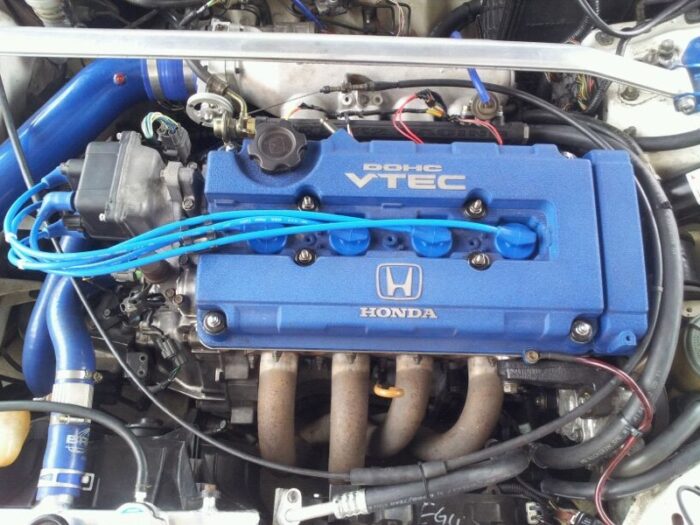Honda’s B20B engine holds a popular place in the Japanese auto industry, having been produced from 1995 to 2002. Primarily known from the first generation of the CR-V, this motor operated within two generations- only separated by minor differences in forced induction. In addition, the B-series range also encompassed engines such as the B16A, B16B, B18B and B18C. Honda’s renowned prowess was stamped all over these motors – offering reliable performance for many years on end.
- The Honda B20 engine series was first introduced in 1995 with the Honda CR-V (1st generation) in America and Japan.
- It is a non-VTEC 2-liter (1973 cc) engine ranging from 125 to 150 horsepower.
- Torque is at its maximum at 4000 RPM.
- In 1999, Honda improved the construction of the B20Z engine for the USDM Honda CR-V.
- The compression rate ranges from 8.8:1 – 9.6:1, but does not seem to change power output significantly.
- Despite its simple construction, it was superior to most American engines at that time and remains popular today due to its reliability and longevity.
Engine specifications for Honda B20B 2.0 l
First generation: B20B – B20B4
| Displacement | 1972 cc |
| Power system | Injector |
| Engine power | 125 – 140 hp |
| Torque | 180 Nm |
| Cylinder block | Aluminum R4 |
| Cylinder head | Aluminum 16v |
| Cylinder diameter | 84 mm |
| Stroke | 89 mm |
| Compression ratio | 8.8 – 9.2 |
| Engine features | DOHC |
| Timing Chain/Belt | Belt |
| Variable Valve Timing (VVT) | No |
| Turbocharger | No |
| Oil capacity/Recommended oil | 3.8 l 5W-30 |
| Fuel type | Regular |
| Euro class | EURO 3 |
| Average lifespan | 350 000 km |
Second generation: B20B – B20B8
| Displacement | 1972 cc |
| Power system | Injector |
| Engine power | 145 – 150 hp |
| Torque | 190 Nm |
| Cylinder block | Aluminum R4 |
| Cylinder head | Aluminum 16v |
| Cylinder diameter | 84 mm |
| Stroke | 89 mm |
| Compression ratio | 9.4 – 9.6 |
| Engine features | DOHC |
| Timing Chain/Belt | Belt |
| Variable Valve Timing (VVT) | No |
| Turbocharger | No |
| Oil capacity/Recommended oil | 3.8 l 5W-30 |
| Fuel type | Regular |
| Euro class | EURO 3 |
| Average lifespan | 340 000 km |
The dry weight of the B20B engine is 150 kg
The B20B engine number is on the block and box junction

Fuel consumption Honda В20В
The Honda CR-V 1998 with manual transmission as an example (l/100km):
| City | 12.6 l |
| Highway | 8.6 l |
| Combined | 10.0 l |
What cars use the B20B 2.0 l
| CR-V 1 (RD) | 1995 – 2000 |
| Orthia 1 (EL) | 1996 – 2002 |
| S-MX 1 (RH) | 1996 – 2002 |
| Stepwgn 1 (RF) | 1996 – 2001 |
Common Problems with the Honda B20B Engine
If you are a proud owner of a Honda CR-V, it is likely that your vehicle is equipped with the Honda B20B engine. This particular model of engine has been around since 1995 and, while it is a reliable option, there are certain issues that you should be aware of. Let’s take a look at some common Honda B20B engine problems and how they can be addressed.
No Hydraulic Compensators
One of the most common issues associated with the Honda B20B engine is that it does not include hydraulic compensators. This means that every 20,000 miles or so you will need to pay for valve system settings in order to keep your car running in peak performance.
Fuel Consumption
The other major problem associated with this type of engine is its fuel consumption. In city traffic, your CR-V with an automatic transmission is likely to show around 15 MPG which isn’t ideal for such a small SUV.
Oil Seals
Oil seals are another area where you may run into trouble if you own a Honda CR-V. This is because the engine is old and oil seals tend to fail more often than on newer engines, leaving behind oil puddles on your driveway or garage floor.
Oil Pump and Thermostat Issues
The oil pump and thermostat are also known to cause problems over time as they degrade due to constant use and exposure to extreme temperatures.
Head Gasket Issues
The head gasket can also be an issue after 150,000 miles or so when it starts leaking coolant into the cylinder head which can lead to further damage if left unchecked.
Timing Belt Issues
Finally, the timing belt can also be problematic after prolonged use as it tends to wear out faster than most other parts in this type of engine set up; thus requiring frequent replacements over time.
The Honda B20B engine has been around since 1995 and while it is still considered a reliable option today, there are certain issues that owners should be aware of before purchasing or using one in their vehicles. From no hydraulic compensators leading to valve system settings every 20 000 miles, poor fuel economy in city traffic and inadequate oil seals causing constant leaks; all the way through to potential head gasket failure after 150 000 miles along with timing belt issues due to wear; these are all common issues associated with this particular model of engine from Honda that owners should be aware of before making any decisions about buying or using one in their vehicles.

How long does a Honda B20B engine last?
- B20 engine has a longevity of around 220,000 miles on average in the US; some car geeks have driven their first-gen CR-Vs for 400,000 miles.
- To ensure engine lives long life, automobile owners are recommended to change oil every 6000-7000 miles and use original Honda oil, set valves every 20,000 miles, only use good fuel, prevent overheating, avoid extreme RPMs and warm up the engine before driving in the morning.
- Other systems such as cooling system, fuel injection, catalytic converter and spark plugs must also be properly maintained to prevent problems.
0 Comments